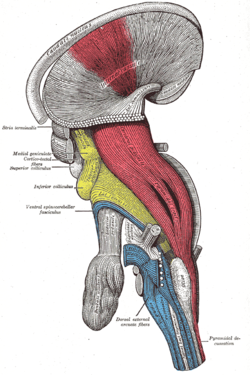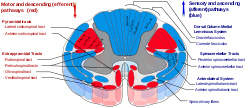Corticospinal
| Corticospinal tract | |
|---|---|

Deep dissection of brain-stem. Lateral view. ("pyramidal tract" visible in red, and "pyramidal decussation" labeled at lower right.)
|
|

Spinal cord tracts, with pyramidal tracts labeled at upper left
|
|
| Details | |
| Identifiers | |
| Latin | tractus corticospinalis |
| MeSH | A08.186.854.633 |
| NeuroNames | ancil-373 |
| NeuroLex ID | Pyramidal tract |
| TA | A14.1.04.102 |
| FMA | 72634 |
|
Anatomical terms of neuroanatomy
[]
|
|
The pyramidal tracts include both the corticospinal and corticobulbar tracts. These are aggregations of efferent nerve fibers from the upper motor neurons that travel from the cerebral cortex and terminate either in the brainstem (corticobulbar) or spinal cord (corticospinal) and are involved in the control of motor functions of the body.
The corticobulbar tract conducts impulses from the brain to the cranial nerves. These nerves control the muscles of the face and neck and are involved in facial expression, mastication, swallowing, and other functions.
The corticospinal tract conducts impulses from the brain to the spinal cord. It is made up of a lateral and anterior tract. The corticospinal tract is involved in voluntary movement. The majority of fibres of the corticospinal tract cross over in the medulla, resulting in muscles being controlled by the opposite side of the brain. The corticospinal tract also contains Betz cells (the largest pyramidal cells), which are not found in any other region of the body.
The pyramidal tracts are named because they pass through the pyramids of the medulla. The corticospinal fibers when descending from the internal capsule to the brain stem, converge to a point from multiple directions giving the impression of inverted pyramid.
The myelination of the pyramidal fibres is incomplete at birth and gradually progresses in caudo-cranial direction and thereby progressively gaining functionality. Most of the myelination is complete by two years of age and thereafter it progresses very slowly in cranio-caudal direction up to twelve years of age.
...
Wikipedia
